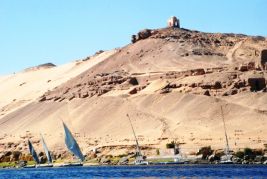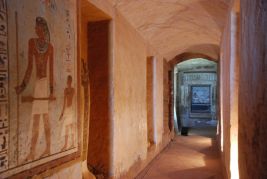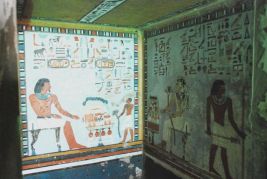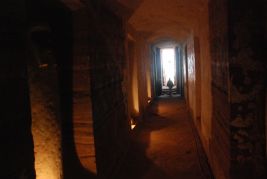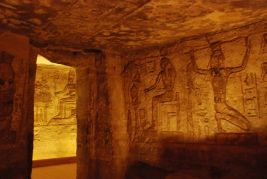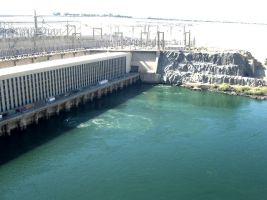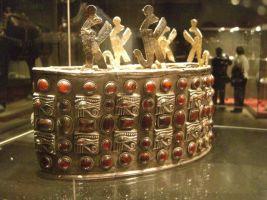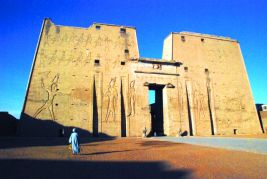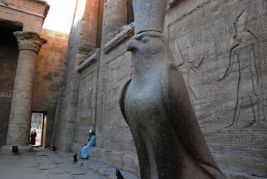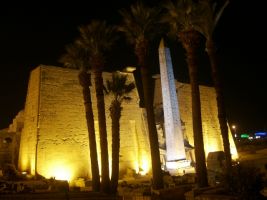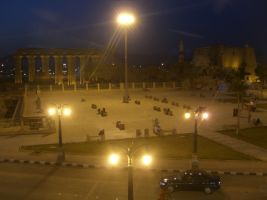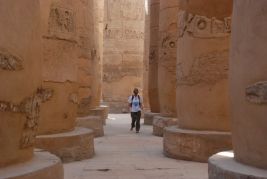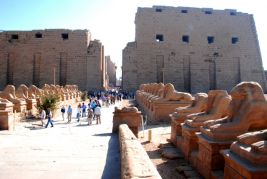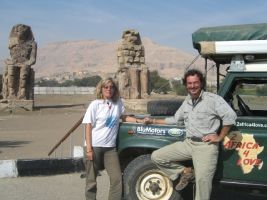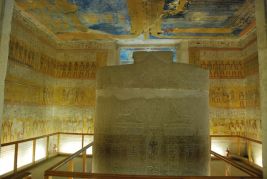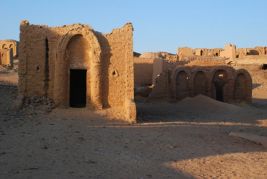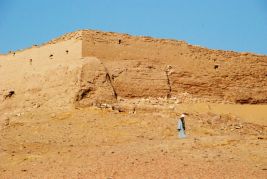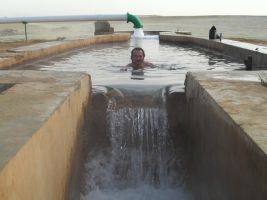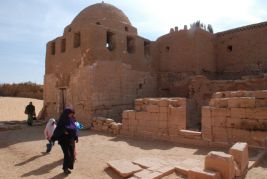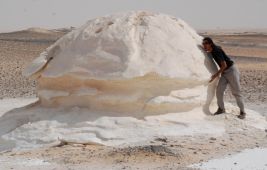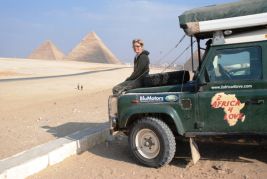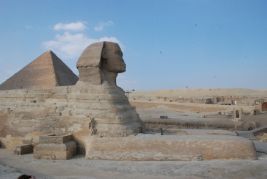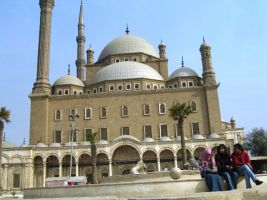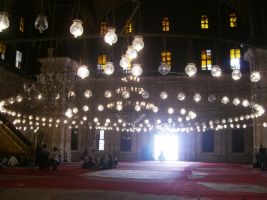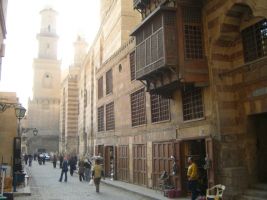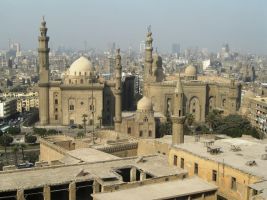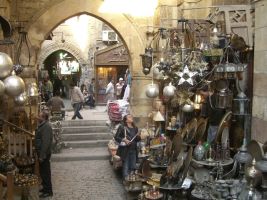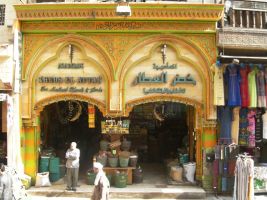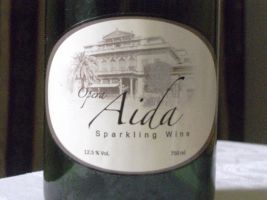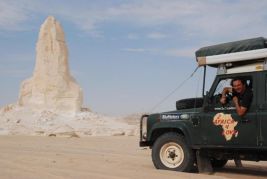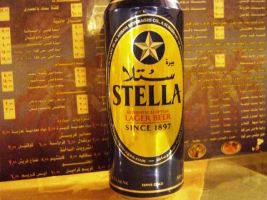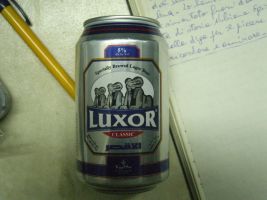
 Italia
Italia France
France Spain
Spain Morocco
Morocco Mauritania
Mauritania Senegal
Senegal Mali
Mali Burkina
Burkina Ghana
Ghana Togo
Togo Benin
Benin Nigeria
Nigeria Cameroon
Cameroon Gabon
Gabon Sao Tomč
Sao Tomč Gabon 2
Gabon 2 Congo
Congo Congo DCR
Congo DCR Angola
Angola Namibia
Namibia Sud Africa
Sud Africa Namibia 2
Namibia 2 Botswana
Botswana Zimbabwe
Zimbabwe Botswana 2
Botswana 2 Sud africa 2
Sud africa 2 Swaziland
Swaziland Mozambico
Mozambico Malawi
Malawi Tanzania
Tanzania Rwanda
Rwanda Uganda
Uganda Kenya
Kenya Etiopia
Etiopia Sudan
Sudan Egitto
Egitto Libia
Libia Tunisia
Tunisia Malta
Malta
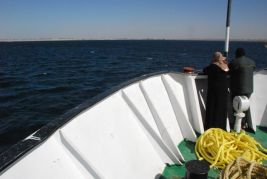
Egypt: our troubles begin – 1 Jan 2009
Our boat arrives on the morning of New Years Day at the port of Aswan.
It is 10:30.
The customs officers climb aboard to begin their checks. We are two of eight Europeans; the other hundred or so people are mainly Egyptians and Sudanese. We fill out the usual forms and they stamp our passport. We are told to wait in our cabins. Hours pass but still, no one is allowed to disembark.
We haven’t a clue as to what complicated checks they could be doing, for what are after all just foot-passengers. Five hours later, we are able to leave. Meanwhile, K7 is now on a ferry heading north. The city is about 20km off so we take a taxi.
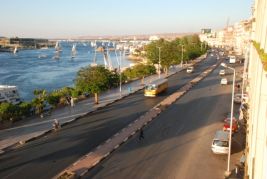
Aswan – 2 Jan 2009
The car still has to arrive, so meanwhile, we are stranded on foot. There is nothing left for us to do, but visit the lovely city.
We lodge in a small but clean hotel with a splendid view of the Nile - The Philae Hotel. It is recommendable, for its position as well as for its price: 150-Egyptian pounds for two people with a substantial breakfast. (20 euro/pounds a day)
GPS N24° 05.349’ E32° 53.664’
Further down the Long Nile there’s a McDonald’s with internet Wi-Fi facility and if you have a meal there then you can surf the net all day for free.
McDonald's GPS N24° 05.693’ E32° 53.825’
Tombs of Princes and Noblemen – 2 Jan 2009
From the western part of the Nile the mountain is excavated at various points. There lie the tombs of the aristocracy; actually large holes in the rocks, full of paintings and bas-relief.
They are of the old and medium kingdom; 3000-years before Christ; Over 5000-years ago.
The feluccas, single-mast boats with one sail, can always be seen in these waters, nowadays more for transporting tourists rather than for fishing.
To see the sites you have to pay a 30-Egyptian pounds or lire entrance fee: LE was how lire were once called. The ticket man offers a low price ticket but only gives you some of the change back, the rest is for him.
Some tombs are protected by locked gates, the guards ask for a further tip if you want the gate to be opened. We threaten to report this to the tourist police in order to get them to open the gate.
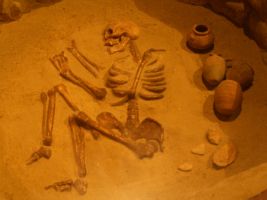
K7 Arrives – 3 Jan 2009
We return to the port by taxi (20km away). During the night K7 arrived by ferry. I drive her onto the dock to undergo the formalities in the customs office.
Unpleasant surprise number-one: the bureaucrat whose turn it is to be there doesn’t recognize the validity of the Carnet de Passage that we completed in Nairobi. He wants to see the renewal on every single piece of paper, not only on the cover where it only needs to be.
It is useless even trying to point this out to him, the renewal on every sheet of paper isn’t necessary because there isn’t a dedicated space for the extension.
Nothing.
He remains resolute. He tells us that only the manager of the Egyptian Automobile Club, Gen. Salah can allow its authorization.
The office is in Cairo, miles away
(In the photo is a picture of the tomb found on the banks of the Nile during the building of a dam. This skeleton, I’m sure, would have had a more open mind than these bureaucrats).
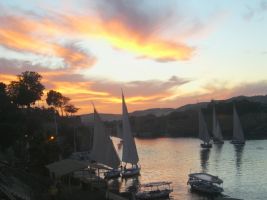
And so, our ordeal begins, one that will last for a week.
The next day we make a call to Cairo with a mediator because at the ACE they don’t speak English. We try and fax the document that we know to be valid and legal, not that it matters. They want to see the original in front of them with their own eyes. We speak to the Office at the Ministry of Tourism, to the head of the General Tourism Office, the kind Mr. HH and to the Tourist Police that only speak Arabic! And then, it's off to the customs office at the General Headquarters in the city with the head of Aswan Customs.
However, it is all pointless. We will have to go to El Cairo. We leave on that same day; at sundown.
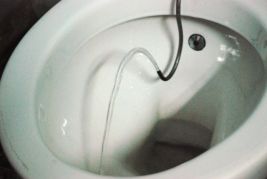
By train, it is 14-hours there and 14-hours back. I travel by night because they don’t want to sell me a day ticket because, I am told, they aren’t very safe.
Once in El Cairo, having found the office, we have to wait for the General Manager Mr. Salah who arrives at 10:30 but only starts receiving at 11:00. Of course, it goes without saying that he doesn’t speak English.
In the meantime, the secretary asks, leaving me completely dumbstruck, what it is that I want, seeing that the document, as she states, IS PERFECTLY VALID!!!
Try explaining this to your dear friends in Aswan!
They write out a declaration that certifies the validity of the document and now I realize the reason I came here. By fax “Mr.” Salah wouldn’t have been able to ask me for the 200-pounds to write out the letter.
It’s no skin off his nose that I have had to travel two nights, pay 1,100-pounds and stay four extra days in a hotel in Aswan just to be here; it isn’t his problem, of course.
(In the photo, a very common idea in Egypt to clean intimate parts and certain faces…)
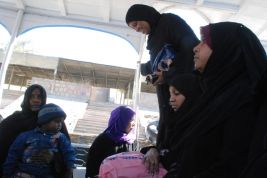
The Document Marathon
Back in Aswan the torment of the documents continues. We arrive at the port by taxi. I have to ask the police guarding the entrance for a ticket to go back into the area and go to the customs office. Still outside, I fill out the form, I pay and then I wait… 30-minutes, an hour, an hour and a half, two hours… I just try to keep calm; I smile, concealing my true thoughts of sending this lot to the place were they ought to go; in particularly, when they openly gawk-at and eye-up western-dressed women regardless, even if the women are accompanied by their partner or husband. Behaviour like this towards their traditionally dressed women could have serious consequences for anyone so careless.
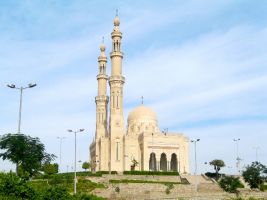
Finally, they take my ticket, now I can get into the actual port.
In the customs office they go through all the formalities, they ask for 472LE to temporarily import the car (having a Carnet de Passage makes no difference).
They write a letter for the road police at the city headquarters.
In the meantime, the taxi that has been waiting outside all morning, takes me to the centre to start the formalities at the police station. Twelve different pieces of paper in order to acquire Arab number plates. Photocopies of the documents, three different payments paid at three different cash desks - about 61LE (8 euro/pounds). Utter bedlam, no queuing, just everyone trying to pay at the same time often shouting and arguing amongst themselves in Arabic.
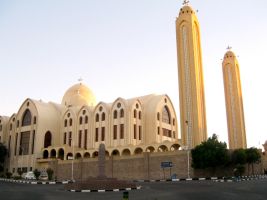
After this we pick up an engineer and a police officer in a taxi from outside Aswan; for 70LE (10 euro/pounds) they don’t make us “wait” too long.
Together, we will get the engine and chassis number of K7 that is at the port.
First it’s the usual 20km taxi ride…
Then back to the city where at two o’clock in the afternoon all the offices are closed, so, we decide to postpone until tomorrow.
HOWEVER;
Tomorrow is the 7th of January, the Copts Christmas day, different to the European one because of the Liturgical calendar.
Here, everyone parties, despite nearly the whole population being Muslim; everything will be closed.
There is nothing we can do.
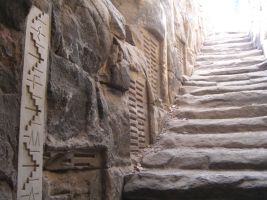
Elephantine Island – 7 Jan 2009
We have nothing left to do but to take a further look around; we decide to visit the Elephantine Island in the middle of the Nile.
We find one of the fascinating Nilometers, one of the most interesting and best conserved in Egypt. With these graduations on the banks of the river the height of the tides can be measured and used to see if they are rising. Thanks to these, the people can foretell the arrival of high water that brings with it the blessings of the gods, filling their shores with water and fertile land brought all the way from Ethiopia and Uganda. Silt, a main resource enriching the population.
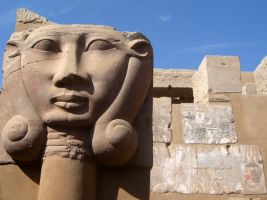
Because of the damn built above Aswan that provides electricity and has created the Nasser lake, the shores no longer fill; those times are now long gone.
On the island along the banks of the river, there are some scattered remains of some of the oldest temples of the gods that the Egyptians believed in. They date back to the first kingdom.
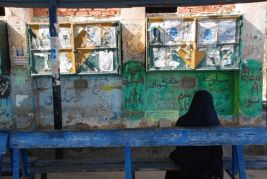
More paperwork
Thankfully they don’t celebrate an equivalent of Boxing Day!
…and so, we can finish with the formalities. We take a taxi to the police station; we have with us our certified chassis and engine numbers and letter for the insurance.
However, they don’t accept the validity of our COMESA Yellow Card that we acquired in Tanzania.
As anyone can see, written on it, in large letters, is that it is accepted in all the east African states including Egypt. We end up paying a further 512LE, obviously for a year, they are so disappointed, and more so when they have to confess to us that they can’t offer any insurance policies valid for just a month! Oh, these poor guys!! They are just so sorry!!!
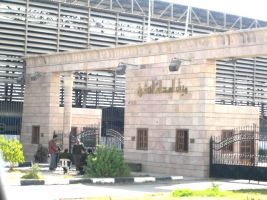
Back at the police station to get the new number plates and then we travel the 20km again to get to the port and finally, we can get our car. But not before the usual fiasco to get in. An hour’s wait and finally we start-up the car. We attach the number plates, but then we learn that we have to pay the customs for all the days that the car has been parked in the port (!!!). We pay, take a receipt, then, wait for it, there is another surprise waiting for us at the gate!
The police ask us to pay for each day the car has been behind the fence. They support this by telling us that they’ve been guarding it. Of course it is useless pointing out to them that I’ve already paid at the customs office.
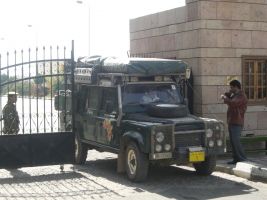
Clearly, a “system of extortion”. With the number plates now mounted I felt I had been pushed to the brink, furious with this treatment, I certainly didn’t want to pay what felt like the hundredth robbery in 20-minutes, but if I had any hope of getting as far away as possible from these annoying, parasitical and treacherous human beings, once again I needed to play ball, I end up giving them 50 quid, a third of their actual price. I finally get the wheels of the car well out of there.
Eight days have passed since our arrival. The have squeezed 2,500 pounds out of us. As well as completely ridding any will to visit the country.
Three cheers for Egypt!!
A country that depends on tourism can also drown people in paperwork along with unscrupulous police and bureaucratic practices.
Useful Tip: Never, I repeat, NEVER come to Egypt with your car!
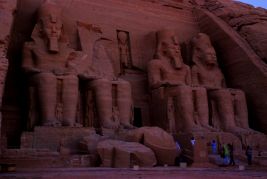
Abu Simbel – 9 Jan 2009
To try and rekindle the love for this country with its wonders and very kind people, we head back 300km south across the desert towards Sudan. Where the hypocrisy of an Egyptian president (Nasser) and the intervention both practically and economically of many European countries that created and resolved the emergency, saving from destruction one of the great wonders of Egypt
The temple of Abu Simbel
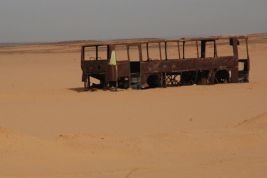
Convoy
We leave in convoy at 11am. Since the terrorist attacks between 1993 and 1999 where Islamic fundamentalists assassinated dozens of tourists by attacking buses and blowing up hotels, the police don’t allow strangers to roam around freely. In the interests of people’s lives and to protect an economy dependent on tourism, armed police escort the tourists. Every morning at 11 and at 4, a convoy leaves to cover the 300km of pure desert towards Abu Simbel. Some signs of the past violence remain rotting in the sand. Even now in low season there are still dozens of buses that take this same route highlighting the importance of this industry in Egypt.
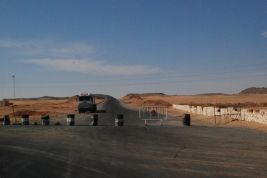
We arrive at an intersection that in a few years will be frequented by travellers entering Sudan or, coming from the south entering this country. The road for Wadi Halfa is just 60km away and is nearly ready. There still aren’t any customs offices as there is still a definitive border agreement to be made, but the head of the local police tells us that it is ready for opening. To our delight this will mean that we can avoid crossing the border with the speculators at port customs, making this crossing quicker, faster and cheaper
Mountain Dug-outs
It seems that in 1817, the Italian Giovanni Battista Belzoni was the first person to enter the temple. It had been discovered a few years before by the Swiss Burckhardt that saw some of its statues sticking out of the sand. Two temples, dug 60metres into the rock-face on the banks of the Nile. Ramses II, one of the greatest pharaohs of Egypt commissioned them 1,250 years before Christ. One was dedicated to him and the other to the beautiful Nefertari, his beautiful companion. Amongst all of his many wives, concubines and love slaves, she was the chosen one; always in his company.
Saved from the water
In 1960 president Nasser initiates the construction of the big Aswan damn. Without any scruples for the Nubian population, the consequences on the artistic beauty of the place and the serious ambient problems. A lake will be the result, and it will destroy the houses and land of 90,000 people. Many temples and monuments dating back 4,000 years will be totally submerged.
UNESCO intervenes in 1964 before the damn is finished, and within 5-years, with an investment of 40-million dollars and employing over 2,000 men (in those days a worker would earn 25 dollars a month!) they excavated and cut up the hill into small blocks and moved it 65metres higher up, safe from the waters of the new lake.
A truly epic achievement.
Going through Aswan again we go and visit the Museum that has a section dedicated to the archaeological treasures that were flooded by the waters.
Edfu – Temple of Horus
Along the banks of the Nile heading north, we encounter the suggestive temple dedicated to the falcon god Horus, built in the Ptolemaic period, in the century of Christ’s birth making it “only” 2,000-years old. We wanted to camp in the car park of the temple but the tourist police wouldn’t allow it. They tell us to go to a place near the cruise-ships. We don’t like it and proceed to Luxor.
Luxor – 10 Jan. 2009
The ancient Thebes, as the Greeks would have renamed it when they arrived. A majestic city that still shines for the wonders built by man 4,000-years ago in honour of gods and pharaohs. Dozens of Temples of Karnac, which are also the biggest in Luxor.
Rows of sphinxes, kilometres of monuments and temples. For millennia this civilization of pharaohs prospered, defeated enemies, celebrated its culture and worshipped the gods. Four thousand years of culture and tradition; absolute uninterrupted power. Comparing them to our relatively young two millennium civilization with huge power shifts, makes you quite vertiginous.
Not far from the city, on the other side of the Nile: the Valley of the Kings and queens. Its temples, with the Colossi of Memnon and his tombs dug into the mountain. Amongst them was the one that preserved the fabulous treasures of Tutankhamun, which can be seen in the museum in El Cairo.
Oasis trek – 14 Jan 2009
We leave the Nile and head into the desert. The track that leads to El Cairo crosses many oases with many signs of the past.
The first one is Kharga with Qasr El-Gueita, a fortress dating to the Persian period, a pharaoh temple and the Christian necropolis of Bagawat, the oldest in the world with 260 tomb-chapels built with unbaked bricks, 300A.D.
There “alone” Dakla – 15 Jan 2009
At this oasis we visit the mausoleum of the sheikh Bashendi. Although, apart from the mud exterior, there really isn’t much to see. Not wanting to be milked anymore by paying the entrance fees to such insignificant places, we decide not to see the other ruins. Instead, we take a nice bath in the hot water (40 degrees Celsius) from one of the various hot springs that spurt out water from 1000metres deep. In this case, at the Farafra oasis.
The white desert - 16 Jan 2009
Like an immense meringue. White chalk rock formations break the surface of the clear sand from what was a deep prehistoric sea. Great scenery scattered with strange and surreal sculptures.
Giza, and the pyramids – 18 Jan 2009
Famous all around the world they are the symbol of Egypt, they still stun the millions of visitors. At their feet lies the mysterious sphinx.
Cairo – 19 Jan 2009
Chaotic, noisy and full of smog from the infernal traffic. Its 20-million inhabitants make it one of the most populated metropolises in the world. We stay for a few days, just enough time to see the city. Founded by the “Ferocious Saladin” in 1176 and embellished with the many mosques.
Cairo is rich with works of Islamic art from the Mamluk Dynasty.
The local market, full of life and visitors is very colourful and very interesting. Vibrant bazaar with perfumed goods, antiques, clothes, spices, silver and gold.
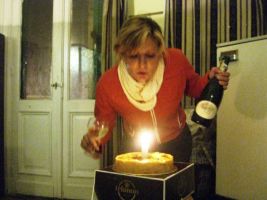
Happy Birthday Laura!
Despite this being an Islamic country, we were able to find a pretty good sparkling white wine; made here in Egypt. The pharaohs were already experts in wine making, so HAPPY BIRTHDAY! The second on this journey
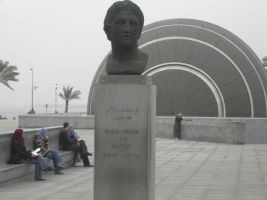
Alessandria – 22 Jan 2009
Founded by Alexander the Great II in 300 B.C. it has always been a cultural centre of great importance. Its library was full of unique documents and precious books. Shame that many of them were destroyed during a fire in the third century. Now a modern library has been built to carry on the traditional culture.
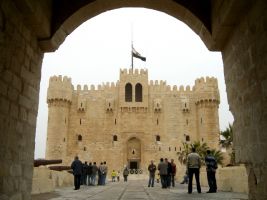
It has been a port with great strategic importance in the Mediterranean. In 1480 this beautiful fortress in white limestone was built by the Mamluk Dynasty. The building was erected over the ruins of the old lighthouse, famous in the history of navigation. It was considered one of the Seven Wonders of the World.
Today, it is pleasant walking through the city amongst the prestigious palaces that date back to the beginning of the century, many of which were designed by Italian architects.
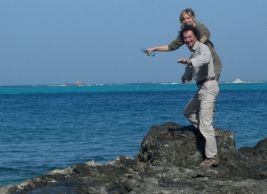
Water of the Nile
We free the water that we had taken from the Nile back in Uganda, pouring it directly into the Mediterranean. We have saved it a journey of 6,400km; it has accompanied us for 12,500km.
We’ll keep a little to take home.
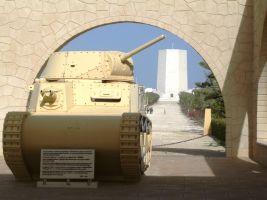
El Alamein – 24 Jan 2009-03-02
Nearly two weeks of battle. Hell on Earth.. During the Second World War, the largest clash in history of tanks and vehicles in open land. On one side the German and Italians that had come through Libya to take over the Suez Canal; on the other side, the Allies had control over the canal. Numerically the Allies had the advantage. Almost twice the amount of tanks (1000) and more than double the men (250,000). The Germans and Italians suffered a catastrophic defeat that cost them dear, loosing all their power in Africa, an important turning point in the war.

On the 2nd of November 1942 they surrendered, 25,000 prisoners with 43,000 Italians losing their lives. The German commanders that were taking their orders directly from Rommel manage to escape. The Italian infantry fought until the bitter end. History tells us of a heroic resistance that destroyed the weapons of the enemy and the deep admiration from the proud Germans.
We go and visit the Italian memorial and the museum that remembers this terrible battle.
There are no words.
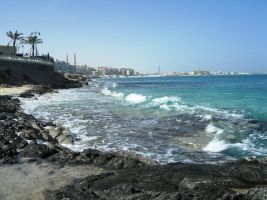
Like Sardinia
We stop at Marsh Matruh. A popular vacation spot for Egyptians with hotels and shops along the sea. Clean crystal clear water and Sun. Apart from the low temperatures in the evening, it’s like being in Sardinia.

El Soloum Frontier – 25 Jan 2009
Our Egyptian number plate has the number 6. But in Arab a 6 looks like our 7. Our K7 continues her tradition of sevens.
An obligatory meeting with our Libyan guide is tomorrow morning at 7am Libyan time (8am Egyptian time). Instead of wasting time, we decide to do the customs formalities for exiting the country today and to sleep in no man’s land so that we will be ready first thing in the morning.
But first a mechanic checks the engine number and chassis and also our Egyptian driving license.
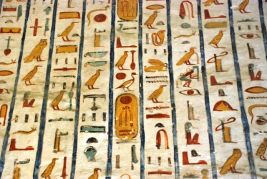
Then to the customs. Outside they check the chassis and body work whilst inside they fill in and stamp the Carnet. They need a photocopy of the Carnet that I already have. They keep the Carnet, I pay 2-LE. Traffic police office, I need to photocopy my passport and also I buy a 2LE folder that I pay 5LE for. I go back to the first office of the mechanic and I hand them everything along with the number plates. I have to pay 3,65LE, but I end up paying 5LE. I then go back to the customs; I show them the paper and get back my stamped Carnet with a paper that I have to show outside. Immigration office, we pay 2LE a head receive our stamps and then we’ve finished. Just an hour and a half, what a difference compared to their colleagues in Aswan!
In total I paid 16LE. There’s an “express service” that they try and convince you to have that costs 100LE, on top of that, is the tip they’ll expect. Do-it-yourself!
We camp in no-man’s land between Libya and Egypt.
Outside the desert wind is blowing.
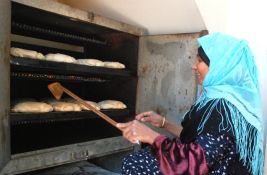
Our Impressions
Egypt is beautiful.
There’s no doubt that the Nile, with its strong presence and impressive array of pharaohs and monuments, makes this country evocative and unique. The seasons temperatures didn’t allow for us to enjoy the splendid sea that is definitely a plus for tourism. HOWEVER, their stubborn and sometimes mean bureaucracy, brings us to the conclusion that we absolutely DO NOT RECOMMEND coming here with a vehicle.
Let’s put it another way DO NOT COME TO EGYPT IN YOUR CAR!
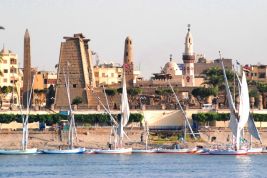
Having said that, we can say with confidence that Egypt is safe. Police are everywhere; Touristic, road, political and military police. Every 50km there’s a road block that registers all the foreigners passing through. They are quick and kind and some of them speak English. The roads are all well kept, road junctions are well marked and signed. Here’s a strange one: nobody has there car headlights on at night! They only use their sidelights and they got angry if we used our headlights (!). Unfortunately there are many vendors, but luckily they aren’t too invasive, despite the fact that they will always try and trick you, but no more than in other parts of Africa, that’s just how it is, it’s just a little more so here; they are the same amongst themselves.
Signs, beers and curiosities
A great sparkling white wine made in Egypt, a strange rock in the shape of a…chisel (?) and zero alcohol beer
